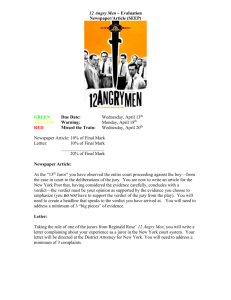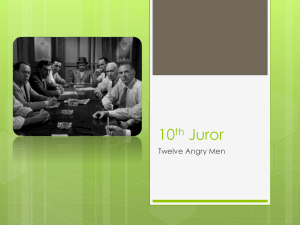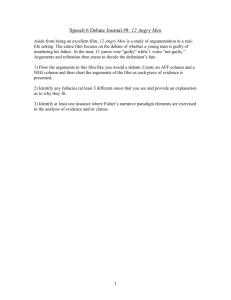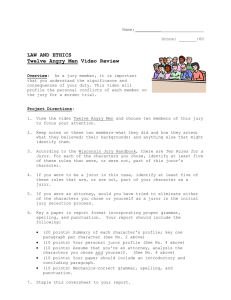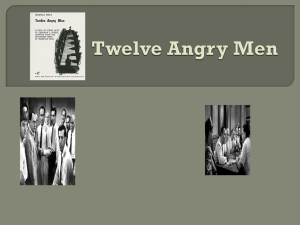12 Angry Men - WordPress.com
advertisement
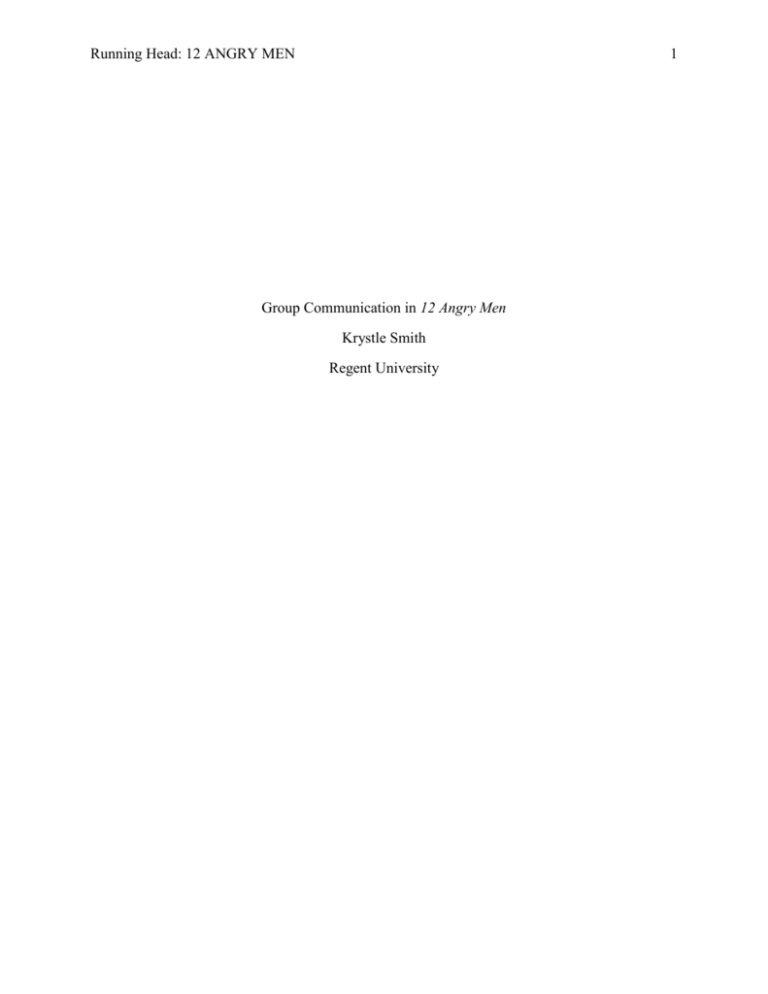
Running Head: 12 ANGRY MEN 1 Group Communication in 12 Angry Men Krystle Smith Regent University 12 ANGRY MEN 2 Group Communication in 12 Angry Men Sometimes, I believe it is easy to classify group communication as a body of people working together in within an organization. I think that most people who think of working in groups are more than likely to draw from experiences in that particular setting however 12 Angry Men allowed viewers and opportunity to see another form of group communication. While there were many elements of group communication involved in this movie, including the role of nonverbal behavior, power struggles, ethical concerns, critical thinking, turn-taking, and a host of other issues, I have selected three areas to cover. My goal with this paper to examine key issues involved in group communication such as: the role of leadership within this group and whether it was effective or not, how personal attitudes towards the backgrounds and cultures of other people heavily influenced the jury’s ability to think rationally, and finally how treatment of jurors by other members of the jury all contributed to not only a stressful but bad communication experience for the men on the jury. Though I have no personal experience with serving on a jury, I do believe this area of group communication is one that should be viewed more heavily because there are so many problems that arise to test each juror’s ability to work together to reach a verdict. Group communication involves many other elements most individuals may be unaware of, or they have given little if any to its importance. Group work in general may be one of the most unpopular activities among people today largely due to the fact that many people have had poor experiences in previous group work. However bad a previous experience may have been, it will still be necessary for you to work in a group in the future so it is important to understand how group communication works and how you can improve your experience in it. Everyone at some point has worked in a group as authors, Lumsden, Lumsden, & Wiehoff (2010) of 12 ANGRY MEN 3 Communicating in Groups and Teams: Sharing Leadership reminded us, “from day one of your life, you were in a group—your family—and this set your expectations of how people act when they are together” (p. 2). Whether you are aware of it, our expectations for group communication seem to develop at a young and because of this, we may be unfamiliar with the some habits or experiences other people bring to the table as we journey into group communication later in life. Most individuals who are able to recall an experience involving group communication or work retrieves a memory from some type of work group assembled. One of the main issues that surfaces within group communication is conflict and at times, more problems can be created with how to resolve the conflict as well. Author Lawrence Frey (2002) of New Directions in Group Communication stated that “the starting place for making any effective decision…is a clear definition of the issue or problem and identification of its causes” (p. 161). Conflict resolution was a big problem that was not easily overcome in this movie. In 12 Angry men, it was clear from the first time the men walked in the jury room, the majority of them seemed confident their deliberation period would end rather quickly. They hd hardly given thought to anyone voting against a guilty verdict. To the jurors, the verdict seemed to be quite simple—and easy. In this case, the group communication occurred within a jury comprised of 12 men who were tasked with deciding the fate of an 18-year old boy accused of stabbing his father to death. He was to face the death penalty if he was convicted of murder, due to the premeditation tag that accompanied the 1st degree murder charge, or he would be acquitted if found “not guilty” by the jurors. Though they were confident in their belief that the defendant was guilty, it took them some time to actually assemble in order for them to cast their first vote; they decided to take an initial vote to see where everyone stood regarding a verdict. 12 ANGRY MEN 4 The designated leader of the jury was the foreman who was probably appointed by the judge. The jury had to work with a leader whom they did not appoint nor did they know anything about but I didn’t seem like a problem especially with the foreman agreeing with the guilty verdict. Lumsden et al., (2010) explained that leadership is “verbal and nonverbal communication that facilitates a team’s transactional and task processes in achieving members’ and the team’s needs and goals” (p. 28). They continued and added that “providing leadership implies responsibility and facilitation” (p. 29) which I feel like in the foreman’s case, he did it the best of his ability under those circumstances. As I have learned over the last few weeks, leadership does not solely fall on the shoulders of the designated leader of a group; instead all members of a group are expected to contribute to the group in some form of leadership. Lumsden et al., (2010) stated that “the complexity of team assignments makes it difficult for a single person to have sufficient knowledge and experience to successfully manage all elements of the work” (p. 29). In this particular case, I felt as though the jury foreman tried his best to lead the jury as he saw fit even through opposition from other jury members. In his first act of duty, the foreman decided to take up a vote to see where everyone stood regarding the verdict. He was proactive with his duties and seemed to handle the group of men with some ease at the beginning of their deliberations. One element of communication I appreciated seeing from the foreman was his ability to ask if everyone if they had any issues with how they voted. He gave an opportunity for others to speak up in the case that someone felt uncomfortable with the way they opted to vote. Throughout the movie, the group voted a number of different ways. They did an initial vote of raising their hands to give their vote, they did a secret ballot vote where the identities of the jurors were excluded, and then they did an 12 ANGRY MEN 5 “open vote” according to their jury number. All methods were useful in that they were able to see at various times through the deliberations where the team stood in their verdict. One interesting note that I was intrigued by was the need for the jury to reach a unanimous decision though it wasn’t required. Some men, who were less than pleased with the duration of the process, seemed to be satisfied with the thought of having a hung jury. They were fine with leaving the decision up to another jury instead of reaching a decision themselves. This is where another juror, the original dissenting juror, stepped up in the form of leadership. Instead of simply going along with the notion of a hung jury, he instead challenged the men to look at the evidence presented in this case. This is something that the foreman could have done but he didn’t, in fact, he seemed content with reporting back with a split jury. There are two conflicts here: the dissenting vote and the refusal to report back as a hung jury. As the deliberations continued, I noticed that the11 men became more impatient and angry with the dissenting juror. Instead of showing a genuine interest in why the juror dissented, they ridiculed him and ostracized him for his vote. Some jurors referred to the dissenting jurors’ opinions regarding the evidence as “fairytales” while others asked him if he had a background in sales, and even questioned his intelligence at times as well. This type of behavior, I believe would rattle some people but this particular juror seemed confident in his beliefs and didn’t back down from his opinion—or his vote. Because of his stance along with a closer examination of the evidence presented, more men began to side with the dissenting juror which caused further conflict within the group. This is where author Andrew G. Ferguson (2012) of Why Jury Duty Matters: A Citizen’s Guide to Constitutional Action makes a good point about protecting the dissenting juror’s opinion. He explained that “respect for individual expression, both as a means to protect the 12 ANGRY MEN 6 autonomy of an individual, and as mechanism to change the minds of others, is central to our system of democratic self-government” (p118). The dissenting juror simply stated that he was unsure of whether the defendant was guilty or innocent however he just wanted others to see that there is definitely room for reasonable doubt. He simply wanted an opportunity to share his thoughts and feelings regarding the doubt with the other men on the jury. As the jury became more frustrated with one another, a lot of personal feelings and attitudes began to rise. There was a division among the men; the dissenting group slowly began to increase in number, which meant that the ruling group in favor of a guilty verdict began to shrink. Over the course of the deliberations, the men grew more restless and allowed outside thoughts and feelings to distract them from their goal. Whether it was “doodling” on a piece of paper or talking about sports, some men found ways to distract themselves from the large issues at hand: reaching a unanimous verdict. One issue regarding obstacles the group needed to overcome could be seen in the various opinions regarding the backgrounds of some juror members. One juror was from a similar background as the defendant. It was mentioned that the defendant grew up in the slums around people who did not have the best reputations, a place where violence was prevalent and where success hardly seemed to be within reach. Though this background information was brought up, it reared its ugly head in the form of a prejudice from one of the jurors. Because of this, the juror felt that a man from that particular part of the world was known to behave like that which made him more capable of committing the crime. Lumsden et al., (2010) touched on how diverse groups can be a good—and seemingly bad thing, for groups to deal with. They stated that “the more diversity within a team, the richer the possibilities—and, perhaps, the greater the dialectical tension and the harder members may 12 ANGRY MEN 7 have to work at dialogue” (p. 207). In this particular case, the cultural differences between three of the members weighed heavily in the deliberation process. First, there was the issue of the defendant’s background (where he grew up) being similar to one of the jurors. This caused some resentment from the juror towards other members because he felt judged due to his less than pleasant upbringing. Then there was the cultural difference of one of the other jurors who happened to be from another country. Though he was not born in the United States, his perceptions of how Americans should behave toward on another positively influenced his ability to reason regarding the verdict. Finally, the prejudices by one of the final dissenting jurors shined a glaring and harsh light on how hard it can be to separate our own beliefs regarding stereotypes of other cultures and what is actually a fact concerning them. Author Hartley (1997) of Group Communication stated that “cultural background partially determines what conflict is permissible and how it should be handled” (p. 128). Though the jurors were at odds of the verdict, they collectively determined that prejudicial attitudes were not going to be accepted. This stance by the group highlighted a powerful aspect of group communication that Hartley touched on. He stated that “the importance of teamwork in problem-solving and decision-making is apparent in a whole range of situations” (p. 6), what better way to show how strong his statement was regarding problem-solving then by the groups stance concerning a particular juror’s prejudicial attitude towards the defendant. The other jurors were not only shocked by his strong words but they also showed how intolerant they were to his opinions as well. The group literally “turned their backs towards him” in a show of disapproval. Soon after, the juror realized the error of his ways and changed his vote to “not guilty”. The solidarity of the group sent a strong message to that juror that despite how you feel about the defendant’s 12 ANGRY MEN 8 background, there will be no toleration of prejudicial or unfair feelings within that group. It also showed their unity whether they were aware of it or not. As they continued to become more united, the stronger they became and towards the end, they were finally able to reach a unanimous verdict. The final point I wanted to highlight regarding this groups communication experiment was the behavior the jurors had towards one another. It was a very angry, hostile and combative at times. Almost from the beginning, after learning that there was a dissenting vote against the “guilty” verdict, there was tension in the air. Authors Frey, Gouran &Poole (1999) of The Handbook of Group Communication: Theory and Research touched on how important this is, they stated that “understanding the relationship between individuals and groups is the dynamic tension that frequently occurs between them” (p. 116). They continued and stated that “some scholars believe “that individuals and groups are inherently in competition because their interests and needs often conflict” (p. 116). Their point is clearly seen with the initial and ongoing tension between the jurors who voted guilty and the one dissenting juror because the desires of the majority was not being met due to the interest in reviewing the evidence by the one dissenting juror. The 11 other members of the jury didn’t understand why this particular juror felt as if the defendant was not guilty of the crimes he was accused of committing. All throughout the entire deliberation process, many jurors talked over one another, dismissed differing opinions, called each other derogatory and offensive names, and became at times, became violent. It did not help that none of the men truly wanted to be there or, that they had to gather on one of the hottest days of the year either as well. 12 ANGRY MEN 9 The dissenting juror’s stance and closer examination of the evidence regarding the reasonable doubt paid off in the end. Not only did the group unite and reach a different decision but they also seemed to grow as individuals as well. The group communication seen within this film is something that everyone will not experience but it is a case that everyone can draw a learning experience from. Recognizing certain negative behaviors and noticing that leadership can come from individuals other than the designated leader are important lessons everyone ought to consider going forward. This group covered a wide range of issues found within group communication, however they managed with some insistence from a dissenting juror to actually work through the case and not simply take the easy road out. In the end, they reached their goal, a unanimous verdict, which is something every group desires to complete at the end of their work. 12 ANGRY MEN 10 References Ferguson, A. G. (2012). Why jury duty matters: A citizen’s guide to constitutional action. New York, NY. New York University Press. Retrieved from: http://0ehis.ebscohost.com.library.regent.edu/ehost/ebookviewer/ebook/bmxlYmtfXzUxMzYxM 19fQU41?sid=4cbc5a7f-16ce-4d79-a48e88421058124a@sessionmgr113&vid=1&format=EB&lpid=lp_117&rid=0 Frey, L. R. (2002). New directions in group communication. Thousand Oaks, CA. Sage Publications. Retrieved from: http://0ehis.ebscohost.com.library.regent.edu/ehost/ebookviewer/ebook/bmxlYmtfXzQ3NDU0 MV9fQU41?sid=1bee78c3-8c17-45f7-9e8bce8f516a98d4@sessionmgr113&vid=1&format=EB&lpid=lp_159&rid=0 Frey, L. R., Gouran, D.S., & Marshall, S. (1999). The handbook of group communication theory and research. Thousand Oaks, CA. Sage Publishing. Retrieved from: http://0ehis.ebscohost.com.library.regent.edu/ehost/ebookviewer/ebook/bmxlYmtfXzYzMjYxX 19BTg2?sid=67651d30-63ba-4d0f-9fdf3a1a3b5cca06@sessionmgr198&vid=1&format=EB&lpid=lp_I&rid=0 Hartley, P. (1997). Group communication. New York, NY. Routledge Publishing. Retrieved from: http://0ehis.ebscohost.com.library.regent.edu/ehost/ebookviewer/ebook/bmxlYmtfXzE2OTQzN F9fQU41?sid=245b971f-7738-48d2-a7ea675b80333a0d@sessionmgr115&vid=1&format=EB&lpid=lp_1&rid=0 Lumsden, G., Lumsden, D., & Wiethoff, C. (2010). Communicating in groups and teams: Sharing leadership (5th ed.). Boston, MA. Wadsworth, Cengage Learning.

